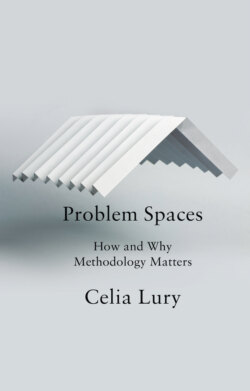Читать книгу Problem Spaces - Celia Lury - Страница 24
Notes
Оглавление1 Bachelard (1970) identifies the importance of what he calls ‘applied doubt’ for the identification of a problematic, in contradistinction to ‘universal doubt’ which, so he proposes, only destroys the world it seeks to investigate. As noted below, Donna Haraway uses the term ‘generative doubt’. 2 Simon holds design to be a ubiquitous practice: ‘Everyone designs who devises courses of action aimed at changing existing situations into preferred ones’ (1996: 111). 3 There is considerable debate as to what it means to ‘represent’ a problem. A compositional methodology, as described in the Introduction, does not consider a problem space to be a representation of a problem, in the sense of re-presenting an external referent, but a relational process of composition, the transformation of a situation. 4 Other writers insist on the importance of re-presentation too, including for example Whitehead, who provides a powerful critique of the limitations of perception in the mode of ‘presentational immediacy’. 5 The criticism of instrumentalism might also be levelled at pragmatism, although most commentators would distinguish between pragmatism’s ethical concern with the difference an idea makes to the world from the instrumental design of problem spaces for predetermined purposes or goals. 6 As will be discussed in the next chapter, the equipping of a situation or environment with a variety of forms of cognition is one of the key transformations in the contemporary epistemic infrastructure. 7 Situated knowledges, she says, are neither totalizing nor relativizing. Indeed, in dismissing both, Haraway sees relativism as the ‘perfect mirror twin of totalization …: both deny the stakes in location, embodiment and partial perspective, both make it impossible to see well’ (1991: 191). 8 She says that this promise arises in conversation, one of the few of Haraway’s terms that has not been widely taken up, but which I draw attention to here because of its resonance with the term correspondence that Dewey uses (and which has recently elaborated upon by Tim Ingold 2016). 9 In this respect, there is a link to the understanding of the methodological potential of pattern, both in the sense in which Dewey discusses, and also in the understanding of figure-ground that has been powerfully developed in anthropology, including, for example, in the work of Alfred Gell (1998; see also Küchler and Were 2005). His Anthropology of Art is an anthropology of agency, in that it shows how art objects index complex collective intentionalities as they circulate. In this sense, they are a form of embodied cognition, what he describes as a form of abductive reasoning.10 As Karel van der Leeuw says, ‘Comparison between different traditions can show which particular form is assumed by problems under different presuppositions, or how a particular answer to a question can make another problem invisible or insoluble … Some aspects of a problem remain invisible, either because the tradition simply ignores the problematic side, or because it poses no problem to it, given its specific outlook on reality. Some solutions remain untouched, because they do not fit in with the expectations of the tradition, or because they are at variance with basic assumptions concerning the nature of reality. Thus we gain an insight into why a particular tradition is haunted by problems that seem to play no role at all in another tradition’ (1997: 323).11 In a discussion of the use of the concept ‘reflex arc’ in psychology, Dewey criticizes what he calls its patchwork of stimulus response and proposes instead the term sensori-motor circuits, by which he means the continual reconstitution and adjustment of organisms-in-environments. Begin, he says, not with the specious ‘stimulus’ (for example, ‘seeing’), but with ‘sensori-motor co-ordinations’, such as ‘seeing-for reaching’ (https://pdfs.semanticscholar.org/a7ab/dafa9cca3547d8f441ee9dc3b5ad19ee7f59.pdf). The ‘response’ that follows is not just ‘reaching’, it is ‘reaching-guided-by-seeing’. He says, ‘the arc is virtually a circuit, a continual reconstitution’ (1896: 360), and ‘It is the circuit within which fall distinctions of stimulus and response as functional phases of its own mediation or completion’ (1896: 370). This description provides a vocabulary – phase, co-ordination and continual reconstitution – with which to address the partial continuities that can be established in relation to the properties of different forms of circulation.12 Importantly for the understanding of problem space being developed here, while the dictionary declares that ‘across’ can be used as a preposition to refer to relations between fixed points (from one side of a river to another for example), it can also mean to pass through, throughout or intersect at an angle, a crossing, to find or meet, and it is these meanings of the word that are enrolled here. A paradigmatic example of how ‘across’ may be accomplished is the method of chiasmus (the dictionary definition of which is a rhetorical or literary figure in which words, grammatical constructions, or concepts are repeated in reverse order, as if across each other) or double proportional comparison as described by Roy Wagner (2019). This is a practice in which the comparisons do not result in an equivalence but a reversed doubling of sameness that results in difference. For Wagner, metaphor is the primary technique of double proportional comparison, ‘the automatic reflex of [the] reinversion [of language] out of itself’: ‘“a metaphor is two words, each dividing the significance of the other between them”’ (2019: xvi). An apt example is Appadurai’s ‘the circulation of forms’ and ‘forms of circulation’.
